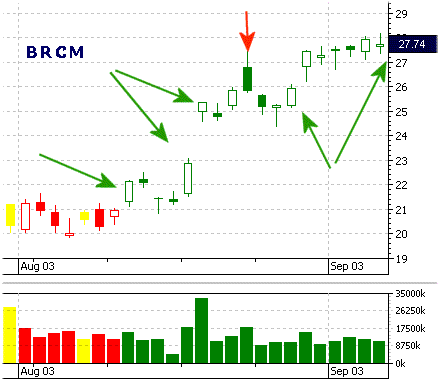| |
|
TRADING TACTICS - Swing Trading Stock Picks |
Swing Trading Stock Picks
Swing Trading Stock Picks identifies
profitable trading opportunities in stocks after their brief period of
consolidation or correction for a quick 5-25% move in 1-5 trading days.
Whether you are a first time investor, a seasoned pro, an "in and out"
day trader or a long term investor, Trading Picks will provide you with
the necessary information you need for maximum profits and success in
today's dynamic markets.
FREE Swing Trading Stock Picks
How to enter a Swing Trade
Do not enter your orders immediately
at the open. Wait for a few minutes for the market to settle
down before entering your orders.
Entry techniques:
| Technique
1: Long Swing Entry |
Technique
1: Short Swing Entry |
|
Buy the stock
from the moment it trades above its BUY ABOVE
trigger price. As soon as you buy, make sure to place a
stop-loss order. |
Sell the stock
short the moment it trades below its SELL BELOW
trigger price. Once you sell short, make sure to place
your stop loss order. |
| Technique
2: Long GAP Entry |
Technique
2: Short GAP Entry |
|
If the stock gaps up
above the trigger price, wait for 30 minutes and then
put a buy stop order above the high of the day.
|
If the stock gaps
down below the trigger price, wait for 30 minutes and
then put a sell stop order below the low of the day. |
How to exit a Swing Trade
Exit techniques and riding the
trend:
- Stop-Loss Order - place
your stop the moment you enter a trade. Exit your trade the
if the stop-loss gets triggered. After each day, simply move
your stop-order to under the low of that day for long
swings, and above the high of that day for short swings.
However.. never set the stop loss at a lower/higher price
than the day before.
- The 50 percent rule -
when you have a 7% gain on your swing trade, book
profits on 50% of your position.
- Riding the wave - ride
the rest of your trade using a trailing stop. After
each day, move your stop-order to the low of that day for
long swings and the high of that day for short swings.
- Gaps - be prepared to
sell your positions if the stock gaps UP for long swings and
to cover your short positions if the stock gaps DOWN for
short swing.
|
|
